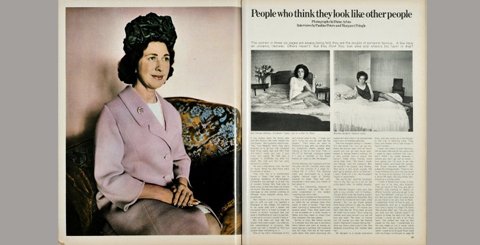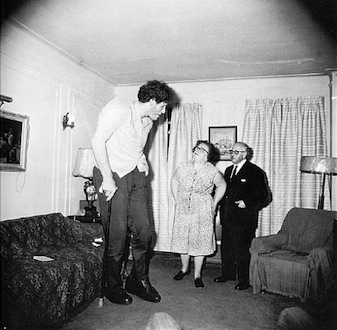
Subcultural Layer
12/05/2011
A retrospective exhibit by the renowned New York photographer Diane Arbus, Pierre Leguillon Presents Diane Arbus: A Printed Retrospective, 1960–1971, has traveled to Vilnius. The exhibit isn’t new. It opened in December 2008 at the Kadist Art Foundation in Paris, and later traveled through France. Last summer the exhibit settled at the Moderna Museet Malmö in Sweden, but this spring, from April 15 through May 28, the retrospective will be on view at the Contemporary Art Center (CAC) in Vilnius. The chance to see Diane Arbus’s works up close is unique and certainly shouldn’t be missed.
Pierre Leguillon’s Traveling Reading Room
The retrospective was created by Pierre Leguillon (1969), a French photo artist, critic, and curator who selected works by Diane Arbus that were published in British and American periodicals from 1960 through 1971, including The Sunday Times Magazine, Esquire, Harper’s Bazaar, and Nova. The collection encompasses almost all of the artist’s publications—more than 150 photographs. The chosen period was a time when Arbus worked most actively and independently on her photography, immortalizing various members of the subculture. The retrospective is unique because Arbus’s creative works have been selected, compiled, and presented in this way for the first time.
It is surprising to learn that the internationally acclaimed photographer participated in only one exhibit during her lifetime: New Documents, at the Museum of Modern Art in New York in 1967. The organizer of the exhibit was the renowned photographer, curator, and art critic John Szarkowski, whose aim was to bring together works by three rising stars of documentary photography: Diane Arbus, Lee Friedlander, and Garry Winogrand. Arbus avoided displaying her works in exhibits, because she was afraid that, if taken outside of context, outside of the story’s photo essay in the format of a report, her intentions could be mistaken. Pierre Leguillon has taken this into account, and therefore created the retrospective without “tearing out” the photographs from the magazine articles they accompanied.
At the CAC in Vilnius, the exhibit has been arranged just as it was elsewhere—in a small gray room with glassed-in magazine spreads arranged along the walls and gray wooden boxes standing in the center of the room, giving an impression of the retrospective’s peripatetic nature. This small room is the perfect size for “sitting down by a pile of yellowing magazines” and getting to know Diane Arbus.
From High Fashion to Documenting Everyday Life
Arbus began her career as a commercial photographer. She received her first camera from her husband, Allan Arbus, whom she married when she was just eighteen. The young couple owned a successful photo studio in New York, and their everyday work regularly appeared in fashion magazines like Glamour. Diane’s duty was to plan the concept, style, and composition of each frame. Allan stood behind the camera. Diane learned from her husband how to develop film and prepare negatives in a “dark room,” which at that time was the young couple’s bathroom.
Alongside this work, Diane began taking her own pictures with a 35 mm Nikon camera, immortalizing people she met on the street. She worked with her husband from 1941 through 1956, when she quit her day job (and, two years later, her husband too) in order to devote herself completely to her art. Her income was still provided by magazine editors, though they now commissioned illustrative materials for interviews and asked her to create documentary photo essays. And it is precisely this time period, when Arbus was working as an independent photo artist, that is displayed at the exhibit on view in Vilnius. Her creative zenith continued until 1971, when, at forty-eight years of age, the internationally acclaimed photographer and mother of two grown daughters took her own life after a lengthy battle with depression.
Freak Show?
Looking at Arbus’s photographs in the exhibit, my first impression was a sour queasiness. All sorts of “freaks” stare out from the portraits: transvestites, nudists, dwarfs, giants, and the mentally ill. Even a pair of identical twins look like an anomaly in this context. “What kind of circus troupe is this?” I involuntarily want to ask. Yet this is only the surface layer. A desire to dig beneath the surface was one of the driving forces in Arbus’s work. Her portraits accent a person’s façade—bodies, costumes, status—and precisely with these frontal portrayals she gives viewers the chance to dig through the surface.
Though she is considered part of the documentary street photography scene that flourished in the 1960s, Arbus differs from her contemporaries because she used classical portrait principles. Unlike moments caught in movement, her frame compositions are not accidental. Arbus was demanding toward her subjects, composing them in a specific way and making them pose without moving. She wanted to tell intimate stories that would dig beneath the shell of an individual. But in order for this to be understood, you must assemble the necessary accents. I will never forget the photograph of a giant who, standing on his feet, is squeezed into the room of a standard-model apartment, or, along with it, the photograph of a decorated Christmas tree about a half meter too high, its bent tip touching the ceiling.
Uncovering the Subcultural Layer
What is hidden underneath this bodily surface layer? What so enticed Diane Arbus? In an interview, the photographer’s ex-husband, Allan, said, “Diane was deeply moved by the subjects of her photographs, and she treated them almost piously. Diane was enticed by their self-image, which contrasted so much with the image in which they were perceived by the world.” It’s possible that Arbus possessed the unique ability to approach various types of “outsiders,” to establish contact with them, on account of the emotional tangles within herself. And she was prevented from untangling them by her episodic bouts of depression. Yet it would be too simplistic and unwarranted to draw these parallels. Just as it is to politely avert your eyes in society from these “freaks,” thinking that to do so is best.
In the picture above: Nova, October 1969, People Who Think They Look Like Other People © 1969 The Estate of Diane Arbus, LLC

Diane Arbus, Jewish Giant at Home, 1970